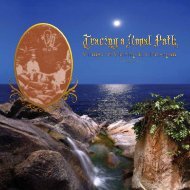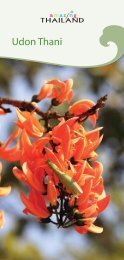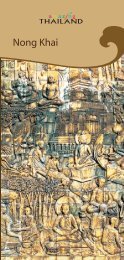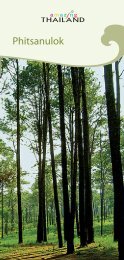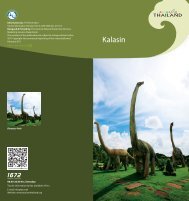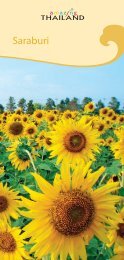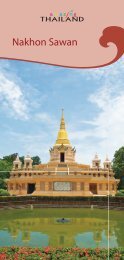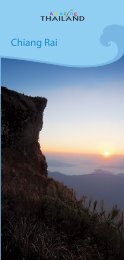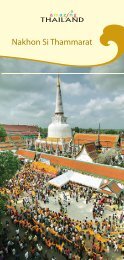Sukhothai - TourismThailand.org - Tourism Authority of Thailand
Sukhothai - TourismThailand.org - Tourism Authority of Thailand
Sukhothai - TourismThailand.org - Tourism Authority of Thailand
Create successful ePaper yourself
Turn your PDF publications into a flip-book with our unique Google optimized e-Paper software.
20<br />
Wat Chang Rop ������������ Situated 2.4 kilometres west <strong>of</strong> Pratu<br />
O, a city gate, the most prominent feature is the circular stupa in<br />
the Ceylonese bell shape, from whose square-base the heads <strong>of</strong> 24<br />
elephants protrude. The ordination hall lies in front <strong>of</strong> the main stupa,<br />
both are surrounded by 5 other smaller stupas.<br />
Wat Saphan Hin ������������� This is situated on a hill 200 metres<br />
high, where a 300-metre pathway <strong>of</strong> slate slabs leads to the sanctuary<br />
yard. A Buddha image called Phra Attharot, 12.5 metres high, in the<br />
Granting Pardons posture stands elegantly in the compound.<br />
Wat Si Chum ����������� Situated 800 metres west <strong>of</strong> Wat Phra Phai<br />
Luang is Wat Si Chum. A wihan in the form <strong>of</strong> a square mondop, which<br />
is the main sanctuary, houses a large monumental stucco Buddha<br />
image in the attitude <strong>of</strong> subduing Mara called “Phra Atchana”, which<br />
is 11.3 metres in width. “Achana” means a person who is not anxious<br />
but strong. The ro<strong>of</strong> has already disintegrated, exposing just 4 walls <strong>of</strong><br />
stuccoed bricks. There is a narrow passageway in the south wall with<br />
steps leading up to the side <strong>of</strong> the Buddha image and onto the top<br />
part <strong>of</strong> the wall. On the wall <strong>of</strong> the passageway features 700-year-old<br />
fainted paintings while on the ceiling are more than 50 engraved<br />
slate slabs illustrating Jataka scenes. A spectacular panoramic view<br />
<strong>of</strong> the <strong>Sukhothai</strong> Ancient City is visible on the ro<strong>of</strong>top accessible by<br />
the passageway.<br />
To boost morale <strong>of</strong> the ancient soldiers was the main reason for such<br />
mystery in Wat Si Chum. The kings <strong>of</strong> the Phra Ruang Dynasty were<br />
famous for that. One could go through the hidden passageway and<br />
address the people through a hole, making them believe the voice<br />
they were hearing was actually the Buddha’s. There are no windows<br />
here. It is believed that a vaulted ro<strong>of</strong> probably covered the wihan.<br />
Sites in the West<br />
Saritphong Dam or Thamnop Phra Ruang�����<br />
������������� Situated in the old city, Saritphong Dam, now restored by<br />
�����������������<br />
the Irrigation Department, comprises earthenworks that stretched<br />
between Khao Phra Bat Yai and Khao Kio Ai Ma. There was a spillway<br />
and pipes to carry water across canals towards the city gates to be<br />
further reserved at the Traphang Ngoen and Traphang Thong Ponds.<br />
Water from these reservoirs was used in the old city and the palace <strong>of</strong><br />
<strong>Sukhothai</strong>. The ancient word for a source <strong>of</strong> water is Sok or stream. In<br />
this connection, various water sources from Khao Prathak include Sok<br />
Phra Ruang Long Phra Khan, Sok Phra Ruang Lap Phra Khan, Sok Phama<br />
Fon Hok, and Sok Chomphu where King Rama VI once paid a royal visit.




